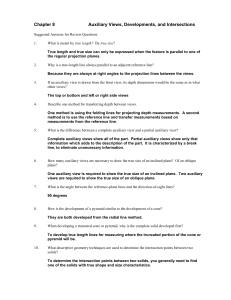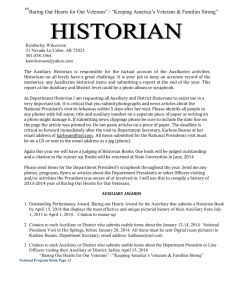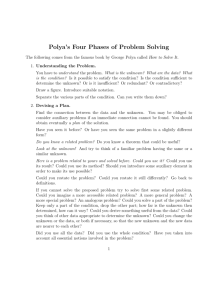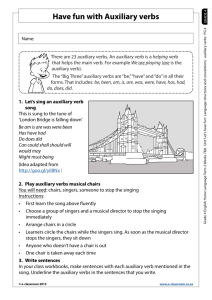State of The Association
advertisement
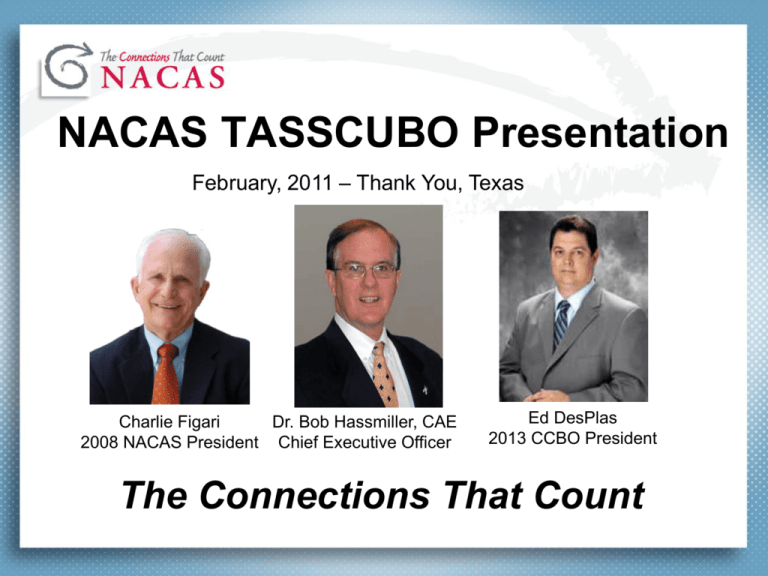
NACAS TASSCUBO Presentation February, 2011 – Thank You, Texas Charlie Figari Dr. Bob Hassmiller, CAE 2008 NACAS President Chief Executive Officer Ed DesPlas 2013 CCBO President The Connections That Count Thank You! Charlie Sallas! Robert (Bob) Brown, CPA • Bob Brown is the Vice President for Business and Administration at Texas A&M UniversityCommerce. He came to work at the University in April, 2006. • Prior to joining the University, Bob served as the vice chancellor of business affairs for the Dallas County Community College District for nine years. He served as only the third chief business officer for the Dallas County Community College District in its almost 40-year history. • Bob has also served as chief business officer for North Harris Montgomery Community College District in Houston and Central Piedmont Community College in Charlotte, North Carolina. He has also served the Dallas County Community College District in various positions including vice president of business for Eastfield College, El Centro College, and Mountain View College, director of business operations at Eastfield College and internal auditor for the Dallas Community College District. • Mr. Brown's professional affiliations include National Association of College and University Business Officers, Southern Association of College and University Business Officers, Community College Business Officers, National Association of College Auxiliary Services, and Texas Association of Community College Business Officers. In 1996, he was named "National Outstanding Business Officer" by the Community College Business Officers. He has twice been named as an Innovator of the Year by the League for Innovation in the Community College. In 2008, Bob received the Distinguished Business Officer Award from the Southern Association of College and University Business Officers. • Mr. Brown earned his bachelor's and master's degrees from the University of North Texas. NACAS Represents an Important Mission • NACAS connects the campus beyond the classroom • We include bookstores, food services, student housing, student centers, conference services, recreation services, child care, communications, concessions, laundry, transportation, parking, printing & copying, mail, purchasing, retail, campus cards, technology, and more Impact of AS: Highlights • • • • Improve student & employee success and diversity Attract and retain students Generate over $40 billion in revenues Provide additional revenue for the institution, as federal, state, and endowment support is decreasing • Make up over 7% of college revenue • Manage auxiliary risk for the institution • Provide succession planning and professional competency support through certification NACAS Facts and Figures • Revenue Generated by Auxiliary Services: – Public 4 year and 2 year institutions: • $28.8 billion • 7.5% of total institutional revenue – Private 4 year and 2 year institutions: • $11 billion • 8.4% of total institutional revenue Data source: 2008 IPEDS, US Dept. of Education (most current source available) Includes intercollegiate athletics (some athletics concession and management revenue is generated by Auxiliary Services) Major Areas Impacting AS • Tremendous budget impact after 10/2008 • Efficient and effective operations (both self-op and outsourced/privatized) • Customer/student service (quality & value) • Social responsibility and sustainability as central operational themes • What and how to contribute to the colleges mission and bottom line • How to find quality AS positions – accountability, core competencies, doing more with less Happy Days Auxiliary Services Current Issues in Higher Education: After the Financial Tsunami • Presenter: John D. Walda, President, NACUBO (National Association of College and University Business Officers) • The financial tsunami dramatically altered the landscape of higher education. John talked about current and pressing topics including increased student demand, demographic shifts, diminished revenue, and competition, and examines how these and other issues affect the future of our institutions. • https://www3.gotomeeting.com/register/511525363 Recent White Paper for the California State University System on Auxiliaries Led by Richard West • Auxiliary Operations: $1.2 Billion • State Funding: 2010 $2.77 Billion going to: $2.29 Billion Ideas to help your bottom line • Charlie Salas – Communications, advertising and more http://www.universitybusiness.com/viewarti cle.aspx?articleid=574 • Bob Brown – Renegotiating Auxiliary Contacts Bill Ballard, University of Vermont • We have saved several hundred thousand dollars campus-wide by switching to once a week cleaning of private offices and the elimination of desk-side waste baskets. In exchange for their basket, we gave out a 2 quart covered plastic container (looks like an old fashion trash can you kept in the garage) in which they could put their banana peels, apple cores, candy wrappers, etc. and then dump it themselves in a central waste collection container/bin on each floor. Everyone still gets a full size recycling bin, which they also have to dump themselves. When you get right down to it, you will find that almost everything you had previously thrown in your basket can actually be recycled. We still provide daily service to all student areas, classrooms and teaching labs, public areas, and rest rooms. My VP is a big advocate of the program and made it clear to his VP colleagues that there would be no executive exceptions. We suspect the President's administrative assistant is coming in early to dump his containers, but everybody else in the executive offices has fallen in line. Overall, the program was successful; once we got past the "you're kidding" statements! Bill Dickerson, Cal State Fullerton • The University had arranged to install Solar Panels on rooftops and parking structures which would reduce the cost of electricity to the campus. They originally approached the auxiliary in the belief that the university was going to have to sub-lease the space on which the panels would be installed to the auxiliary -- which would then turn around and lease the space to an “outside provider” who was providing the panels (and would continue to own the panels). • When we learned that this was essentially a case involving “3rd party financing” so that the university didn’t have to put up the initial $6 million for the solar panel installation -- (and knowing that such financing typically charged anywhere from 12-18%) -- we suggested that the auxiliary might serve as the financing vehicle wherein our loans to the university (0.5% above WSG Prime -- about 4% today) would be significantly less expensive -- AND MOST IMPORTANTLY -- the university would “own” the panels outright instead of remaining the property of the 3rd party financier. Martha Davidson, Duke University • • • • DUKE COST SAVING MEASURES Goal: Reduce university operating budget by $125M over 3 years ….. permanent reductions while – – – – – Protecting core commitments Reducing personnel costs Taking other cost-saving steps Sustain investment in faculty resource Maintain momentum in strategic areas – Protect quality of student experience Options in approach: increase revenue , reduce expenses Formed DART (Duke Administrative Reform Team) Asked for ideas from the University and have received more than 175 ideas through the “Enduring a Troubled Economy” website Auxiliary Services (Duke) • • • • • • • • University initiatives had direct impact on Aux Services: Computer replacement cycle extension caused ~$2M reduction in sales for Computer Store Loss of personnel from early retirements and vacancy management – with limited reduction in operating hours requires more multi-tasking and focus from remaining staff to cover more square footage and more tasks. Forced us to take closer look at new ways to deploy work. Also, challenge if all the things we were doing were absolutely necessary. Retail Operations made changes to hours of operation. Looked at market trends and customer patterns to reduce hours of operation without negatively impacting customers or compromising sales Postal service volume reductions in volume = concern for % returns based on volume of contract station, especially when USPS faces such daunting losses Renegotiated contracts with Dining vendors – Duke retains higher commission Renegotiate contracts with other suppliers With reductions in travel, looking for creative ways to stay in touch with colleagues for new innovative ideas. • • • • • • • REDUCING NON-PERSONNEL COSTS (Duke) Paperless pay statements – moved to online pay statements for all employees in July 2009 to save on printing and distribution costs. All employees who have chosen to have their paycheck automatically deposited in their bank account can see their monthly paystubs online at Duke@Work Telephone savings – converting almost all phones on campus and in health system to Voice over Internet Protocol (VoIP) – sends phone calls over the existing computer network which eliminates the need for dedicated phone lines and switching equipment and lowers the cost per line (at end of 2-year conversion will save $2.7M per year compared to current costs) Extending the cycle for computer replacement by 1 year (from 3-4 years to 4-5 years) Negotiate discounted prices for computers for level 1, level 2, level 3 – most employees are level 1 and computer options have already been determined prior to purchase. Any changes require approval of a senior officer. Combination of these 2 changes will result in $2M savings annually. Consolidation of servers to central server rooms – save on utilities, space, staffing, off-site backups, etc. University-wide (Duke University) • • • • • • • REDUCING PERSONNEL COSTS Early retirement incentive option offered – 895 BW and 90 monthly chose this option and most positions were not refilled Vacancy management – must submit request to respective VP to fill ANY vacancy (secure approval of EVP) Managing Overtime – limit or eliminate where able to . Curtailed external hiring and limiting use of consultants and contract services – to hire must provide justification and request approval from EVP or Provost Fringe Benefits increases – kept increases in insurance rates lower by increasing co-pays for visits and prescriptions, implementing incentive to use prescription mail order, ….) • • • • • • Energy conservation – policy for temperature standards and hours of operation. Temp control in older buildings is difficult to maintain. Reducing carbon footprint as part of “Going Green” campaign. Grounds – less frequently mowed grass, less weeding and slightly longer waits for maintenance requests in non-critical areas. NCAA athletic fields are maintained according to schedule due to collegiate regulations. Closed the Student Health Pharmacy – due to rising operational costs. Other pharmacies are available to students without continuing operation of one on campus. Renegotiate lease space agreements – between University and Health System nearly 2.2M s.f. leased space. School of Law opted to send holiday card electronically rather than by USPS. Fuqua Business School – each of faculty agreed to teach one extra course for this academic year . Allowed schools to cover teaching needs of its new master’s in management science program without having to hire extra faculty. Outcomes: These changes have reduced costs enough to get us halfway toward the $125M cuts. – – • $125M target has been reduced to $100M (per news article 9/24/10) Have cut $60M; just $40M to go by 2013 HOWEVER, some of the reductions above caused Aux Revenues to decrease Robert Valenti, Fairleigh Dickinson University • At Fairleigh Dickinson University, a large part of what we do is focused on providing outstanding customer service. To that end, we have have initiated departmental Quality Service Initiatives (QSI's) loosely based on the Disney model of customer service. These QSI's were prepared departmentally by department heads and management teams from our business partners, ie food service, mail, college store etc., that were fortunate enough to attend a four day training session at the Disney Institute in Orlando. We have also hosted Disney service events on each of our campuses for business's in our surrounding communities. The end result of these QSI's has been a clearer focus on understanding the wants and needs of the customer, and following through on delivering the best possible outcomes in each individual scenario. My tag line has been that we have enahanced the meaning of educations 3R's, Reading, Righting and Rithmatic, and applied them to Higher Education now defined as Recruitment, Retention and Return on Investment. The bottom line for my auxiliary areas is that we continually strive to provide not good, but outstanding service in the hope that not only our students, but our faculty, staff and business partners will be proud to say they are a part of our FDU community. This in turn leads to easier recruitment, a better retention rate of students, and a higher return on investment through satisfied alumni and business partners. Susan Nowicki, Delta College (MI) • • • • • Established a Business & Auxiliary Services Outreach Program. This is a program in which we communicate, via email, on a monthly basis to all department heads. In the email, which is brief, we highlight what may be going on in the auxiliary departments that may be of interest. Categories include: Important dates (i.e., textbook buyback, check runs, internal charge deadlines for auxiliary depts. Open house, Food Service chili cookoff, bookstore sales, etc.); Resources (how-to guides available, etc.); In the Know (vendor discounts, IRS changes, use of college funds); Community (Printing Services hosting career complex students, students selecting charities, etc.); How To (always contains a procedural educational item), and WOWs (i.e., Printing Services achieving FSC certification, etc). This has been very well received. Auxiliary Services sponsors scholarships each year through our foundation office that we call “CASE” scholarships --- College Auxiliaries Support Education An email is sent to all new employees welcoming them to the college, which highlights a brief overview of each of the auxiliaries and includes a “who to call” list. Again, very well received. An assessment is conducted for each year for each of our auxiliary departments. Topics include: Executive Summary; previous year in review; situational assessment (operational profile, staffing, SWOT, equipment, competition/outsourcing, technology, financial, sustainability); Benchmarks/Metrics (perceptions, sales, financial and cost, industry-related); Blueprint for the Future (strategic objectives, critical success factors, trends, near term financial actions, budget projections, action plans, marketing, CQI). All of our auxiliaries are in-house and include Printing Services, Food Services, Bookstore, Fitness & Recreation Center as well as Business Services/Purchasing. Comprehensive marketing plan for all auxiliaries and how they relate to each of the College’s strategic objectives and action plans. Ideas from your colleagues • Jean Anne Caywood – Savannah State Of all of the decisions we have made in the past 4-1/2 years I have been at Savannah State, I believe the one that has been most helpful to us overall has been to outsource our mail center operations. When I arrived, we had funds for one full-time and one half-time staff (neither of which were managers) to service the almost 2,000 mailboxes which we provide to all resident students and university departments. We were able to increase our headcount after the first year to two full-time staff and hired a manager for the second position, but he left after six months due to the pay. At the time he left, it was time for us to bid out our document center management, and we decided to include both document center and mail center services in our RFP. Within less than three months after we hired a service provider for the mail center, years of poor procedural management and customer service complaints were turned around. As an added benefit, I no longer had to worry if one or both of my mail center employees were unable to come to work. The contractor hired our one remaining full-time employee, and she is happy with the transition as well. We were able to negotiate a contract for the document center services which helped us pay most of the difference between the cost of the management service in the mail center and our former salary allocation, so the additional financial cost to the State was negligible. • Leslie Craigmyle of SUNY Oneonta • SUNY Oneonta switched to essentially one dining plan for all resident students (Diane Williams gave a presentation on it in Hawaii). That has really been working well for us. In fact, we just did a resident dining survey and overall, satisfaction is high. • John Langlois of Assumption College (MA) Bob- here's a revenue enhancing idea that we are implementing. Using "University-Rooms.com" or similar as a new internet rental agency for summer rental of designated Res hall rooms. They have an online system like hotel reservations that market & book summer rentals for a commission. They even do the ecommerce • Matthew Portner, Ashland University (OH) • Here are some customer service ideas that we have implemented just this last year: 1) Secret Squirrel mystery shopper program (utilizing students as the mystery shoppers evaluating the various service departments 2) Text & Tell: new service that replaces comment cards by enabling students to send in comments via text directly to our management team. Meets the students where they are with technology and provides a quicker and more focused response. 3) Much more integrated use of Zoomerang surveys. This year alone we have done major service surveys to customers of Printing, Bookstore, and Catering. Key here is the strategic meetings that follow and crafting the appropriate responses and operational adjustments. Jim McDermott, Southern Illinois Univ – Edwardsville • • • Increase use of debit card. Market debit card and even give the students an incentive to put money on the card. Once they have money on the card we can now market a cashless University and offer the students specials if the use their card. We have proven that if the student does not need cash they will spend and spend more. Use loyalty card in all dining areas and even the bookstore. Buy 10 drinks and get the 11 free, or buy 6 books and get a 7th free or at a reduced price. Find a way to make sure the students and faculty and staff do not want to or need to leave campus. The more we offer at a reasonable price the more we will sell especially with not having to use cash.

